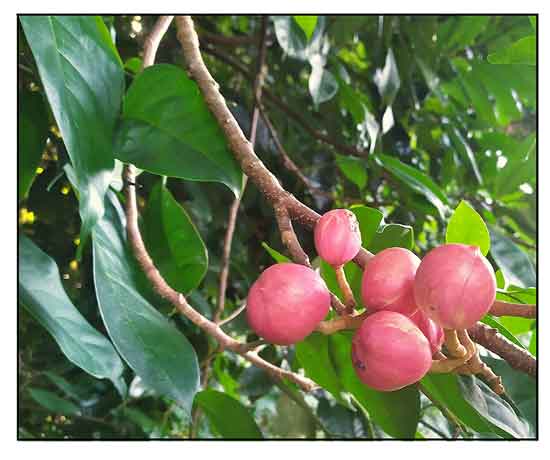
Family • Meliaceae
Kalimutain
Goniocheton arborescens Blume
MOSSMAN MAHOGANY
| Scientific names | Common names |
| Aglaia halmaheirae Miq. | Kalimutain (Ifugao) |
| Aglaia macrophylla Teijsm. & Binn. | Mossman mahogany (Engl.) |
| Alliaria arborescens (Blume) Kuntze | |
| Alliaria halmaheirae (Miq.) Kuntze | |
| Alliaria kunthiana (A.Juss.) Kuntze | |
| Alliaria maingayi (Hiern) Kuntze | |
| Alliaria nernstii (F.Muell.) Kuntze | |
| Dysoxylum arborescens (Blume) Miq. | |
| Dysoxylum arborescens f. ceramicum Miq. | |
| Dysoxylum arborescens var. timorense (Miq.) C.DC. | |
| Dysoxylum arborescens f. timorense Miq. | |
| Dysoxylum forsythianum Warb. | |
| Dysoxylum gjellerupii C.DC. | |
| Dysoxylum halmaheirae (Miq.) C.DC. | |
| Dysoxylum halmaheirae var. subobovatum C.DC. | |
| Dysoxylum insulare Pierre | |
| Dysoxylum kunthianum (A.Juss.) Miq. | |
| Dysoxylum maingayi Hiern | |
| Dysoxylum nernstii F.Muell. | |
| Dysoxylum novohebridanum C.DC. | |
| Dysoxylum rubrum Merr. | |
| Dysoxylum sibuyanense Elmer | |
| Epicharis kunthiana A.Juss. | |
| Goniocheton arborescens Blume | |
| Goniocheton insularis Pierre | |
| Hartighsea acuminata Miq. | |
| Hartighsea sumatrana Miq. | |
| Trichilia arborescens (Blume) Spreng. | |
| Goniocheton arborescens Blume is an accepted species. KEW: Plants of the World Online | |
| Other vernacular names |
| NEW GUINEA: Abungusevarak, Ai, Bepon, Meia, Sagowai. |
| SUMATRA: Kaju kupang, Kaju longgajan. |
| VANUATU: Nemawte. |
January 2024
![]()
 |
| PHOTOS / ILLUSTRATIONS |
| IMAGE SOURCE: Dysoxylum arborescens / Fruit and leaves / Steve Fitzgerald / CC BY-SA 4.0 International / Click on image or link to go to source page / Wikimedia Commons |
| IMAGE SOURCE: Dysoxylum arborescens / Leaves / Steve Fitzgerald / CC BY-SA 4.0 / Click on image or link to go to source page / Wikipedia |
| IMAGE SOURCE: Dysoxylum arborescens / Close-up of flower / Jago B / Australian National Botanic Gardens / CC BY-NC-ND / Click on image or link to go to source page / Useful Tropical Plants |
Additional
Sources and Suggested Readings |
• |
DOI: It is not uncommon for links on studies/sources to change. Copying and pasting the information on the search window or using the DOI (if available) will often redirect to the new link page. (Citing and Using a (DOI) Digital Object Identifier) |
| List of Understudied Philippine Medicinal Plants |
| New plant names needed The compilation now numbers over 1,300 medicinal plants. While I believe there are hundreds more that can be added to the collection, they are becoming more difficult to find. If you know of a plant to suggest for inclusion, please email the info: local plant name (if known), any known folkloric medicinal use, scientific name (most helpful), and, if possible, a photo. Your help will be greatly appreciated. |
• |
 |




